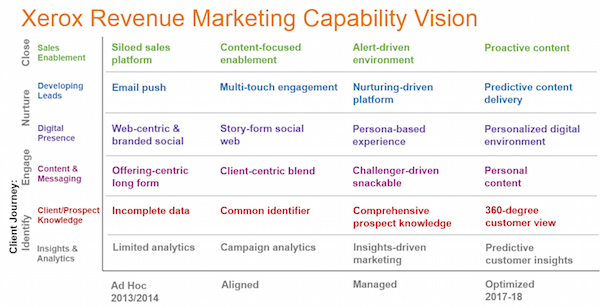Marketo is one of the leading providers of marketing automation software.
“No IT” was one of their early selling points, and I remember thinking at the time that represented a major inflection point in marketing’s relationship with technology.
So I was excited to have the opportunity to interview Jon Miller, their VP of Marketing Content and Strategy, on the impact they’ve seen technology have in the marketing department over the past 6 years.
Here’s his perspective:
Marketo was one of the first marketing technology companies to emphasize “no IT” as one of its value propositions to marketers. What does the relationship between IT and marketing look like these days?
In the past, the relationship between IT and marketing was strained. IT departments have always been incentivized to focus on revenue generating aspects of an organization, but too often marketing was seen as a cost center. As a result, marketing had to fight for resources, and they began looking for ways to take matters into their own hands. Five years ago, if a marketer created his or her own end-to-end campaign, that was a revolutionary feat.
Today, with the use of new analytics, Marketing is increasingly taking on the role of a revenue driver in the organization. That’s a key reason why Gartner reports that by 2017 the CMO will spend more on IT than the CIO. And it is also changing the relationship with IT. CIO’s are stepping in to work with marketing more than ever — so now there is less work around and more work together.
Now that CMO’s are selecting and operating marketing technology platforms such as yours — for most CMO’s, that’s uncharted territory — how are they adapting to this new responsibility? What challenges do they still face?
Even if we have marketing automation that is easy to buy, easy to own, and easy to use, it doesn’t mean that marketing is easy. In fact, marketing has become increasingly more complicated as the buyer landscape has shifted. This means the modern CMO has to focus on three key areas:
Process: As the old saying goes, “don’t pave the cowpaths.” In other words, don’t automate old and bad processes when you are introducing a new technology into your organization. Instead you have to quickly iterate, and be open to changing old habits. New technology will require a new way of doing things. Additionally, you have to re-align how marketing works in tandem with the rest of the organization. Sales and marketing alignment is a huge part of a marketing department’s success, so re-think how the two teams work together.
“New technology will require a new way of doing things.”
Content: Content is the fuel that feeds the technology. You need to have great content to feed your entire sales pipeline from the top of the funnel, to your lead nurturing and content that signals buying intent when downloaded. Marketing software is powerful, and can score your leads based on the content they download. But again, you need a variety of content for this to be successful, and you need to think about your buying stages and personas. Unfortunately, many companies don’t have content that is non-promotional. Self-promotional content does not work, especially in the early stages of buying. Invest in thought leadership.
Skills: Because technology is so prevalent in modern marketing, proficiency with marketing software and in-depth knowledge of online channels are both crucial for your team’s success. Additionally, your talent must be both technologically adept and analytical. They must think about process and optimization. Traditional marketing skills are useful as well, but a well-rounded team will have these newer skills as well.
“Because technology is so prevalent in modern marketing, proficiency with marketing software and in-depth knowledge of online channels are both crucial for your team’s success.”
With all this new technology in the mix, what does the modern marketing org chart look like? Are there new roles? New arrangements of existing roles?
Yes. At Marketo we talk about the Demand Center. As you grow as a company, you need to organize for scalability. At Marketo, we have built a hub and spoke model that we call the Demand Center. Around the Demand Center we have Inbound, which focuses on social and other inbound programs, and various Demand Generation Teams, who have quotas and execute our key programs. The Demand Center does about 30-40% of our core Marketo program work to support the Program Managers and Inbound Teams.
The Demand Center has the following divisions:
- Integrated Marketing: This is like our service bureau. The Integrated Marketing team builds landing pages and emails, supporting the Program Teams.
- Middle of the Funnel: They are in charge of creating our nurturing campaigns.
- Marketing Operations: This team is really focused primarily on technology, data, and measurements.
- SDRs (Sales Development Reps): Our sales front line. They are the first to respond to and qualify marketing leads.
How is the “technologification” of marketing departments effecting their expectations and relationships with agencies?
Done well, there is opportunity to create more alignment. Applications such as Basecamp, wikis, etc. have already begun to revolutionize these relationships. Additionally, collaborative cloud technologies have enabled work to be conducted from any computer, anywhere in the world. And as marketing software becomes more prevalent, there will be even more synergy and alignment.
As an example, today lead generation agencies deliver flat spreadsheets with a long list of leads on a weekly, monthly, or one-time basis. This is a pain for a marketer. They are slow to respond and you have lost valuable data on what they are doing and how they are interacting with your content. But when marketing departments and lead generation agencies share common technology, the leads and information can be synced in real time, and behavioral data is never lost.
“When marketing departments and lead generation agencies share common technology, the leads and information can be synced in real time.”
Over the 6 years since Marketo was founded, you’ve worked with thousands of marketers around world. What are some of the other changes in marketing management that you’ve seen over that time?
The two biggest changes I have seen in marketing are better marketing measurements and the evolution of how we use social.
It has long been the Holy Grail to measure marketing activity and program ROI, but attributing impact has been difficult — there are often too many touches. In the last few years it has been possible to see touches and understand all contributions, dramatically improving marketing ROI and decision making.
Social has changed the way marketers can interact with the buyer and track their engagement over time.
Marketers can leverage applications for social publishing, social media monitoring, presence management, and social campaigning. And today there is a new opportunity for marketers to experiment with peer-to-peer sharing to provide a social lift to every campaign that are already doing. It took a few years to figure out how to use the web as a marketing tool, and now we have to figure out social. There is so much more to social than just publishing on Facebook and Twitter.
Thanks, Jon!



